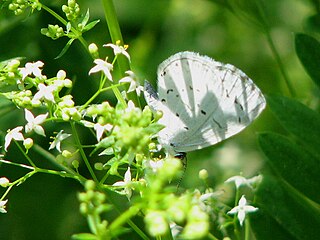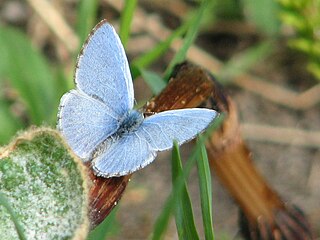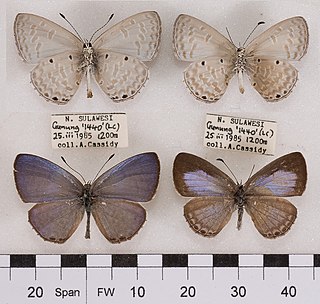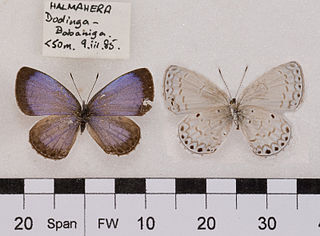
The holly blue is a butterfly that belongs to the lycaenids or blues family and is native to the Palearctic.

Celastrina is a genus of butterflies in the family Lycaenidae found in the Palearctic, Nearctic, Indomalayan and Australasian realms.

Feniseca tarquinius, the harvester, is a butterfly of the family Lycaenidae, and the only member of the monotypic genus Feniseca. It is found in eastern North America.

Monodontides is a genus of butterflies in the family Lycaenidae. The species of this genus are found in the Indomalayan realm and the bordering Palearctic realm.

Plautella is a genus of butterflies in the family Lycaenidae. It is a monotypic genus containing Plautella cossaea found in the Indomalayan realm Malaya, Java, Sumatra and Borneo.

Sancterila is a genus of butterflies in the family Lycaenidae.

The Appalachian azure is a butterfly in the gossamer wings family Lycaenidae. The male is light blue on the upperwing with a narrow, dark line running along the edge of the forewing. The underwing is chalky white and is dotted with small, pale dark spots. The very back of the hindwing has a row of dark spots running along the edge and contained by a faint zigzagging band. Females are similar to the males but have broad dark wing borders instead of the male's narrow ones. The adult butterfly has a 1.1–1.4-inch (2.8–3.6 cm) wingspan. It is the largest azure in the area.

Celastrina neglecta, the summer azure, is a butterfly of the family Lycaenidae. It is found in North America. Layberry, Hall, and Lafontaine, in The Butterflies of Canada, describe the species:
The upper surface is pale blue with an extensive dusting of white scales, especially on the hindwing. In some females the blue is almost entirely replaced by white with a small amount of blue near the wing bases. Females have a broad blackish-grey band on the outer third and costa of the forewing. The underside is chalky white to pale grey with tiny dark grey spots and a zigzagged submarginal line on the hindwing.

Celastrina serotina, the cherry gall azure, is a butterfly of the family Lycaenidae. It is found across North America as far north as the treeline. Its flight time is between mid-May and mid-June in eastern Ontario after the spring azure and before the summer azure. The larva has been reported to feed on galls of eriophyid mites and apparently also on the mites themselves, making them one of the rare species of carnivorous Lepidoptera. It is commonly found around woodland roads of upland mixed deciduous hardwood forests which are surrounded by wetlands.

Eriophyes is a genus of acari that forms galls, specially on trees of the family Rosaceae. Some are called blister mites. The blue butterfly Celastrina serotina has been reported to feed on these galls and also on the mites, making it one of the uncommon carnivorous Lepidoptera.

Celastrina lucia, the lucia azure, northern azure, eastern spring azure or northern spring azure, is a species of butterfly of the family Lycaenidae. It is found eastern North America, ranging from the Maritimes south through the Appalachian Mountains to West Virginia.
Monodontides apona is a butterfly of the family Lycaenidae. It is found on Mindanao in the Philippines.

Monodontides kolari is a butterfly of the family Lycaenidae. It is found on Sulawesi.

Udara selma is a species of butterfly of the family Lycaenidae. It is found in South-east Asia.

Udara dilectissima is a species of butterfly of the family Lycaenidae. It is found in South-east Asia.

Celastrina idella, the American holly azure, is a species of butterfly of the family Lycaenidae. It is found on the east coast of the United States.

Lycaenopsis haraldus, Felder's Hedge Blue, is a butterfly in the family Lycaenidae. It was described by Johan Christian Fabricius in 1787. It is found in the Indomalayan realm.

Celastrina philippina is a small butterfly found in the Indomalayan realm and which crosses the Wallace Line into the Australasian realm that belongs to the lycaenids or blues family.



















